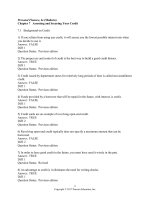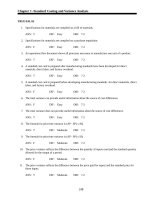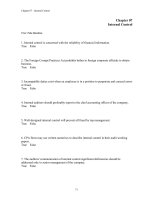chapter 7 test bank
Bạn đang xem bản rút gọn của tài liệu. Xem và tải ngay bản đầy đủ của tài liệu tại đây (113.61 KB, 7 trang )
Chapter 7 – Bond Markets
1. _______ bonds require the owner to clip coupons attached to the bonds and send them to the issuer to
receive coupon payments.
A) Bearer
B) Registered
C) Treasury
D) Corporate
sh is
ar stu
ed d
vi y re
aC s
o
ou urc
rs e
eH w
er as
o.
co
m
2. Note maturities are usually _______, while bond maturities are _______.
A) less than 10 years; 10 years or more
B) 10 years or more; less than 10 years
C) less than 5 years; 5 years or more
D) 5 years or more; less than 5 years
3. Investors in Treasury notes and bonds receive _______ interest payments from the Treasury.
A) annual
B) semiannual
C) quarterly
D) monthly
4. Since 2001, the Treasury has relied on _______-year bonds to finance the U.S. budget deficit.
A) 30
B) 20
C) 10
D) 5
5. Interest earned from Treasury bonds is:
A) exempt from all income tax.
B) exempt from federal income tax.
C) exempt from state and local taxes.
D) subject to all income taxes.
Th
6. _______ bids for Treasury bonds specify a price that the bidder is willing to pay and a dollar amount
of securities to be purchased.
A) Competitive
B) Noncompetitive
C) Negotiable
D) Non-negotiable
7. Treasury bond dealers:
A) quote an ask price for customers who want to sell existing Treasury bonds to the dealers.
B) profit from a very wide spread between bid and ask prices in the Treasury securities market.
C) may trade Treasury bonds among themselves.
D) make a primary market for Treasury bonds.
8. A ten-year, inflation-indexed bond has a par value of $10,000 and a coupon rate of 5 percent. During
/>
315
316 ❖ Chapter 7/Bond Markets
the first six months since the bond was issued, the inflation rate was 2 percent. Based on this
information, the coupon payment after six months will be $_______.
A) 250
B) 255
C) 500
D) 510
9. Bonds issued by the _______ are backed by the federal government.
A) Government National Mortgage Association (Ginnie Mae)
B) Federal Home Loan Mortgage Association (Freddie Mac)
C) Federal National Mortgage Association (Fannie Mae)
D) All of these are insured by the federal government.
sh is
ar stu
ed d
vi y re
aC s
o
ou urc
rs e
eH w
er as
o.
co
m
10. Municipal general obligation bonds are _______. Municipal revenue bonds are _______.
A) supported by the municipal government’s ability to tax; supported by the municipal government’s
ability to tax
B) supported by the municipal government’s ability to tax; supported by revenue generated from the
project
C) always subject to federal taxes; always exempt from state and local taxes
D) typically zero-coupon bonds; typically zero-coupon bonds
11. In general, variable-rate municipal bonds are desirable to investors who expect that interest rates will
_______.
A) remain unchanged
B) fall
C) rise
D) do none of these
12. The municipal yield curve is typically _______ than the Treasury yield curve, and the shape of the
municipal yield curve is _______ the shape of the Treasury yield curve.
A) lower; similar to
B) higher; very different than
C) lower; very different than
D) higher; similar to
Th
13. Corporate bonds that receive a _______ rating from credit rating agencies are normally placed at
_______ yields.
A) higher; lower
B) lower; lower
C) higher; higher
D) none of these
14. Which of the following institutions is most likely to purchase a private bond placement?
A) commercial bank
B) mutual fund
C) insurance company
D) savings and loan association
15. A protective covenant may:
A) specify all the rights and obligations of the issuing firm and the bondholders.
/>
Chapter 7/Bond Markets ❖ 317
B) require the firm to retire a certain amount of the bond issue each year.
C) restrict the amount of additional debt the firm can issue.
D) do none of these.
16. A call provision normally:
A) allows the firm to call bonds at par value.
B) gives the firm the option to call bonds at market value.
C) allows the firm to call bonds at a price below par value.
D) requires the firm to call bonds at a price above par value.
sh is
ar stu
ed d
vi y re
aC s
o
ou urc
rs e
eH w
er as
o.
co
m
17. When would a firm most likely call bonds?
A) after interest rates have declined
B) if interest rates do not change
C) after interest rates increase
D) just before the time at which interest rates are expected to decline
18. Assume U.S. interest rates are significantly higher than German rates. A U.S. firm wanting to issue
bonds could achieve a lower financing rate, without exchange rate risk, by denominating the bonds in:
A) dollars.
B) euros and making payments from U.S. headquarters.
C) euros and making payments from a German subsidiary.
D) dollars and making payments from a German subsidiary.
19. Bonds that are not secured by specific property are called:
A) chattel mortgage bonds.
B) open-end mortgage bonds.
C) debentures.
D) blanket mortgage bonds.
20. Bonds that are secured by personal property are called:
A) chattel mortgage bonds.
B) first mortgage bonds.
C) second mortgage bonds.
D) debentures.
Th
21. The coupon rate of most variable-rate bonds is tied to:
A) the prime rate.
B) the discount rate.
C) LIBOR.
D) the federal funds rate.
22. Assume that you purchased corporate bonds one year ago that have no protective covenants. Today, it
is announced that the firm that issued the bonds plans a leveraged buyout. The market value of your
bonds will likely _______ as a result.
A) rise
/>
318 ❖ Chapter 7/Bond Markets
B) decline
C) be zero
D) be unaffected
23. About _______ of all junk bonds issues are used to finance takeovers.
A) one-tenth
B) one-fifth
C) one-third
D) two-thirds
sh is
ar stu
ed d
vi y re
aC s
o
ou urc
rs e
eH w
er as
o.
co
m
24. _______ bonds have the most active secondary market.
A) Treasury
B) Zero-coupon corporate
C) Junk
D) Municipal
25. Some bonds are “stripped,” which means that:
A) they have defaulted.
B) the call provision has been eliminated.
C) they are transferred into principal-only and interest-only securities.
D) their maturities have been reduced.
26. _______ are not primary purchasers of bonds.
A) Insurance companies
B) Finance companies
C) Mutual funds
D) Pension funds
27. Leveraged buyouts are expected to _______ managerial efficiency and _______ the level of corporate
debt.
A) reduce; reduce
B) reduce; increase
C) increase; increase
D) increase; reduce
Th
28. As a result of the Financial Institutions Reform Recovery and Enforcement Act (FIRREA), savings
institutions were required to phase out their investment of _______ bonds.
A) zero-coupon
B) junk
C) municipal
D) revenue
29. Which of the following statements is true regarding STRIPS?
A) They are issued by the Treasury.
B) They are created and sold by various financial institutions.
C) They are not backed by the U.S. government.
D) They have to be held until maturity.
E) All of these statements are true regarding STRIPS.
30. (Financial calculator required.) Harry Potter can purchase bonds with 15 years until maturity, a par
value of $1,000, and a 9 percent annualized coupon rate for $1,100. Mr. Potter’s yield to maturity is
_______ percent.
A) 9.33
B) 7.84
/>
Chapter 7/Bond Markets ❖ 319
C) 9.00
D) none of these
31. (Financial calculator required.) Ed Wood, a private investor, can purchase $1,000 par value bonds for
$980. The bonds have a 10 percent coupon rate, pay interest annually, and have 20 years remaining
until maturity. Mr. Wood’s yield to maturity is _______ percent.
A) 9.96
B) 10.00
C) 10.33
D) 10.24
E) none of these
sh is
ar stu
ed d
vi y re
aC s
o
ou urc
rs e
eH w
er as
o.
co
m
32. Jim Carrey, a private investor, purchases $1,000 par value bonds with a 12 percent coupon rate and a
9 percent yield to maturity. Mr. Carrey will hold the bonds until maturity. Thus, he will earn a return
of _______ percent.
A) 12
B) 9
C) 10.5
D) More information is needed to answer this question.
33. Which of the following is not true regarding zero-coupon bonds?
A) They are issued at a deep discount from par value.
B) Investors are taxed annually on the amount of interest earned, even though the interest will not be
received until maturity.
C) The issuing firm is permitted to deduct the amortized discount as interest expense for federal
income tax purposes, even though it does not pay interest.
D) Zero-coupon bonds are purchased mainly for tax-exempt investment account, such as pension
funds and individual retirement accounts.
E) All of these are true regarding zero-coupon bonds.
34. Which of the following is not true regarding the call provision?
A) It typically requires a firm to pay a price above par value when it calls its bonds.
B) The difference between the market value of the bond and the par value is called the call premium.
C) A principal use of the call provision is to lower future interest payments.
D) A principal use of the call provision is to retire bonds as required by a sinking-fund provision.
E) A call provision is normally viewed as a disadvantage to bondholders.
Th
35. If interest rates suddenly _______, those existing bonds that have a call feature are _______ likely to
be called.
A) decline; more
B) decline; less
C) increase; more
D) none of these
36. Which of the following is not mentioned in the text as a protective covenant?
A) a limit on the amount of dividends a firm can pay
B) a limit on the corporate officers’ salaries a firm can pay
C) the amount of additional debt a firm can issue
D) the appointment of a trustee in all bond indentures
E) All of these are mentioned in the text as protective covenants.
/>
320 ❖ Chapter 7/Bond Markets
37. The yield to maturity is the annualized discount rate that equates the future coupon and principal
payments to the initial proceeds received from the bond offering.
A) true
B) false
38. Treasury bond auctions are normally conducted only at the beginning of each year.
A) true
B) false
39. Under the STRIP program created by the Treasury, stripped securities are created and sold by the
Treasury.
A) true
B) false
sh is
ar stu
ed d
vi y re
aC s
o
ou urc
rs e
eH w
er as
o.
co
m
40. The yield curve for corporate bonds is normally affected by interest rate expectations, a liquidity
premium, and the specific maturity preferences by corporations issuing bonds.
A) true
B) false
41. A private bond placement has to be registered with the SEC.
A) true
B) false
42. Many bonds have different call prices: a higher price for calling the bonds to meet sinking-fund
requirements and a lower price if the bonds are called for any other reason.
A) true
B) false
43. Bonds are issued in the primary market through a telecommunications network.
A) true
B) false
44. Corporate bonds can be placed with investors through a public offering or a private placement.
A) true
B) false
Th
45. When a corporation issues bonds, it normally hires an investment bank that targets large institutional
investors such as pension funds, bond mutual funds, and insurance companies.
A) true
B) false
46. Rule 144A allows small individual investors to trade privately-placed bonds (and some other
securities) with each other without requiring the firms that issued the securities to register them with
the SEC.
A) true
B) false
47. Rule 144A creates liquidity for securities that are privately placed.
A) true
B) false
/>
Chapter 7/Bond Markets ❖ 321
48. Corporate bonds are more standardized than stocks.
A) true
B) false
49. Structured notes are issued by firms to borrow funds, and the repayment of interest and principal is
based on specified market conditions.
A) true
B) false
50. Bonds issued by large well-known corporations in large volume are illiquid because most buyers hold
these bonds until maturity.
A) true
B) false
sh is
ar stu
ed d
vi y re
aC s
o
ou urc
rs e
eH w
er as
o.
co
m
51. The over-the-counter bond market is served by bond dealers, who can play a broker role by matching
up buyers and sellers.
A) true
B) false
52. Bond dealers do not have an inventory of bonds.
A) true
B) false
53. Bond dealers specialize in small transactions (less than $100,000) in order to enable small investors to
trade bonds.
A) true
B) false
Th
54. Many bonds are listed on the New York Stock Exchange (NYSE).
A) true
B) false
/>
Powered by TCPDF (www.tcpdf.org)









